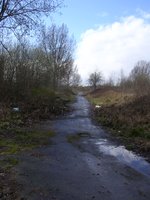A 2 month project at Merseyway Centre will be carried out to revive the damaged, old fashioned building and give the gateway to the town a new lease of life.
Richard Paxton, centre director of Merseyway said: "Merseyway Shopping Centre is one of the oldest in the UK and so needs a specialist company to undertake the work.
"This entrance is highly important as it is the first impression of Merseyway from the main A6 road and the bus and train stations."
The local authority revealed this week plans which could help create 500 jobs across Stockport by siting a multi-million pound blue chip business parrk at Tiviot Way, Portwood. The site was originally earmarked by IKEA.
 As part of the town's regeneration efforts, one of Stockport most notorious housing estates at Gorsey bank, Cheadle Heath is also set to be demolished this summer.
As part of the town's regeneration efforts, one of Stockport most notorious housing estates at Gorsey bank, Cheadle Heath is also set to be demolished this summer.[I don't know what they are going to find to knock down, apart from lamp posts. The houses went long ago, leaving only the road network - Bill]
The council will apply for £1.5m for urgent strengthening work to the grade II listed High Lane Canal Bridge, which carries Buxton Road over the Macclesfield Canal.
Valuable land under stores
I look at buildings and believe they just don't build them like they used to
This is most apparent near the Portwood Tesco, where an old mill nearby is now used by retail outlets. It is 5 storeys high whereas Tesco is almost as high but has, mostly, just one floor.. I will not mention B&Q - inside which the Town Hall could perhaps be fitted!
When was it that companies started to build these very tall but mostly empty buildings sprawling over millions of square meters? And more importantly - why?
Tesco and those like them could hae a mush smaller 'footprint' if they had only put a second floor over the entire area. The same can be said about the carparks. Why can they not build multi-storey ones? Why can they not build carparks under the buildings as basements?
The costs must add to the price of the goods and the cost to the environment must be horrendous.
[I suspect the answer is that planning guidelines deliberately prohibit excessive density of development to reduce the loading of cars onto the road network. It would be nice, however, if the land was used more efficiently so that the remainder could be park space - but that would be more expensive to maintain and risk restrictions being placed on future developments. - Bill]
Park becomes a pond
Manchester Road Park, in Heaton Chapel, which was once dubbed "the forgotten park" because of lack of equipment, is under water after recent wet weather - and people living nearby can't get access to it.
A council spokesman said there was still standing watrer on part of the park, but 80% of it was clear and children are able to use the play area during their Easter holdidays.
"The new drain in the park is completely clear and we are further investigating the culvert which goes on to private property near the entrance to the park", he added.
Landmark mill enjoys new lease of life
Goyt Mill has stood proudly as a one of Marple's biggest landmarks since 1907. The original moll had at its heart a 2,500hp steam engine which drew water from the adjoining canal, and along which the coal to feed this massive powerplant was also delivered.
But by 1960 the then-owner, plastic foam manufacturer Kay Metzler, sought permission to demolish it, and use the land for housing.
Peak Gas, then operating from Arrowsmith Mill in nearby Glossop, stepped in and bought the site. Adapting a formula which had been successful at the Glossop site, Peak Gas set up its own offices at Goyt Mill and set about rentin ght rest of the space to other small firms.
Today, the mill has upwards of 80 tenants, operating businesses ranging from engineering and textile manufacturing to a gym and snooker club/restaurant.
Back in time to fancy '40s
Do you remember the old IKEA adds that comanded us all to chuck out the chintz? Well, those of you who ignored this message - aren't you glad you did? You should be smiling because chintz has been back in fashion for a good year or so now. And the style, once popular in the 1940's, has now been adopted by many designers.
Unbelievably, people in the 1940s had a truly optimistic outlook on life, which can definitely be seen demonstrated in their cheerful home decor.
Do you recall this bookie?
I am trying to recall the surname of a leading independent bookmaker from the early 1960s.
His trade name was Score Racing and his office was at the top of Brinksway on the Cheadle Road.
I am sure his first name as Fred.
Can any old historian of punter help?
Frank Ravlen, Woodley
[If anyone has the answer, email me on stockporttrust@ntlworld.com and I will forward it to Frank Ravlen - Bill]
[For the latest letter on the horse controversy in the Stockport Letters page, see the comments to last weeks posting, here.